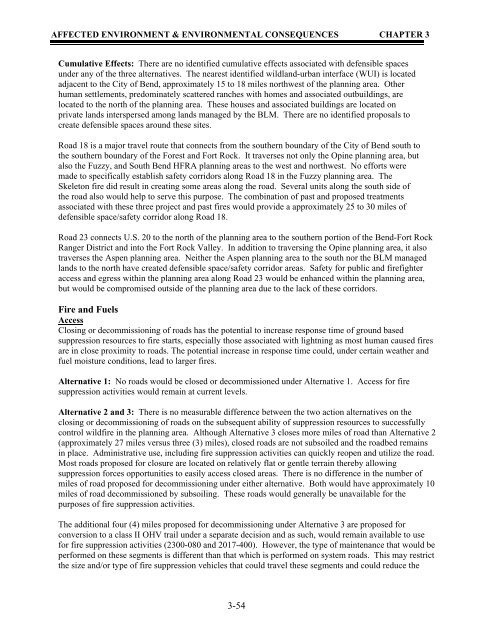Environmental Assessment
Environmental Assessment
Environmental Assessment
You also want an ePaper? Increase the reach of your titles
YUMPU automatically turns print PDFs into web optimized ePapers that Google loves.
AFFECTED ENVIRONMENT & ENVIRONMENTAL CONSEQUENCES CHAPTER 3<br />
Cumulative Effects: There are no identified cumulative effects associated with defensible spaces<br />
under any of the three alternatives. The nearest identified wildland-urban interface (WUI) is located<br />
adjacent to the City of Bend, approximately 15 to 18 miles northwest of the planning area. Other<br />
human settlements, predominately scattered ranches with homes and associated outbuildings, are<br />
located to the north of the planning area. These houses and associated buildings are located on<br />
private lands interspersed among lands managed by the BLM. There are no identified proposals to<br />
create defensible spaces around these sites.<br />
Road 18 is a major travel route that connects from the southern boundary of the City of Bend south to<br />
the southern boundary of the Forest and Fort Rock. It traverses not only the Opine planning area, but<br />
also the Fuzzy, and South Bend HFRA planning areas to the west and northwest. No efforts were<br />
made to specifically establish safety corridors along Road 18 in the Fuzzy planning area. The<br />
Skeleton fire did result in creating some areas along the road. Several units along the south side of<br />
the road also would help to serve this purpose. The combination of past and proposed treatments<br />
associated with these three project and past fires would provide a approximately 25 to 30 miles of<br />
defensible space/safety corridor along Road 18.<br />
Road 23 connects U.S. 20 to the north of the planning area to the southern portion of the Bend-Fort Rock<br />
Ranger District and into the Fort Rock Valley. In addition to traversing the Opine planning area, it also<br />
traverses the Aspen planning area. Neither the Aspen planning area to the south nor the BLM managed<br />
lands to the north have created defensible space/safety corridor areas. Safety for public and firefighter<br />
access and egress within the planning area along Road 23 would be enhanced within the planning area,<br />
but would be compromised outside of the planning area due to the lack of these corridors.<br />
Fire and Fuels<br />
Access<br />
Closing or decommissioning of roads has the potential to increase response time of ground based<br />
suppression resources to fire starts, especially those associated with lightning as most human caused fires<br />
are in close proximity to roads. The potential increase in response time could, under certain weather and<br />
fuel moisture conditions, lead to larger fires.<br />
Alternative 1: No roads would be closed or decommissioned under Alternative 1. Access for fire<br />
suppression activities would remain at current levels.<br />
Alternative 2 and 3: There is no measurable difference between the two action alternatives on the<br />
closing or decommissioning of roads on the subsequent ability of suppression resources to successfully<br />
control wildfire in the planning area. Although Alternative 3 closes more miles of road than Alternative 2<br />
(approximately 27 miles versus three (3) miles), closed roads are not subsoiled and the roadbed remains<br />
in place. Administrative use, including fire suppression activities can quickly reopen and utilize the road.<br />
Most roads proposed for closure are located on relatively flat or gentle terrain thereby allowing<br />
suppression forces opportunities to easily access closed areas. There is no difference in the number of<br />
miles of road proposed for decommissioning under either alternative. Both would have approximately 10<br />
miles of road decommissioned by subsoiling. These roads would generally be unavailable for the<br />
purposes of fire suppression activities.<br />
The additional four (4) miles proposed for decommissioning under Alternative 3 are proposed for<br />
conversion to a class II OHV trail under a separate decision and as such, would remain available to use<br />
for fire suppression activities (2300-080 and 2017-400). However, the type of maintenance that would be<br />
performed on these segments is different than that which is performed on system roads. This may restrict<br />
the size and/or type of fire suppression vehicles that could travel these segments and could reduce the<br />
3-54
















